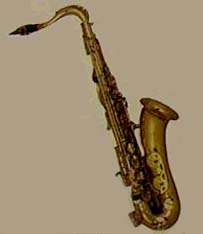The Saxophone
In comparison with the other widely used single reed instrument, the clarinet, the saxophone employs a conical air column compared to the clarinet's cylindrical column. This implies that it sounds all harmonics of the air column rather than just the odd harmonics of a closed cylinder. It also implies that the first upper register is one octave up (2nd harmonic) rather than an octave plus a fifth (3rd harmonic) for the clarinet.
Within a register, opening a hole will shorten the air column and produce a higher note. This sounds simple, but saxophone construction shows that it is not! The precise amount of "shortening" of the air column depends upon the size of the hole. For a large hole, the effective length is essentially the distance from the mouthpiece to the hole, but for smaller holes the length is effectively longer than that. For saxophones, the holes for higher notes (holes nearer the mouthpiece) are small, but they are made progressively larger for lower notes. For the larger of these holes, keys are necessary to accomplish their covering.
Ingham suggests that there is a median taper for the cone that affects the tuning of the upper harmonics: "A cone that is too closed renders the upper harmonics progressively sharp, whilst a cone that is too open will overblow flat." p27.
|
Index
Woodwind instruments
Musical instruments |
